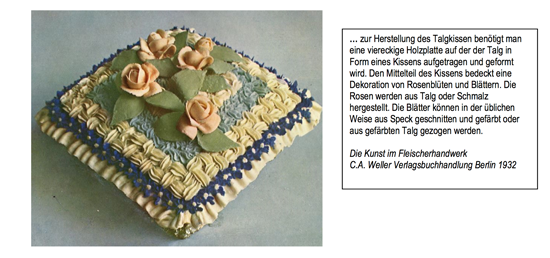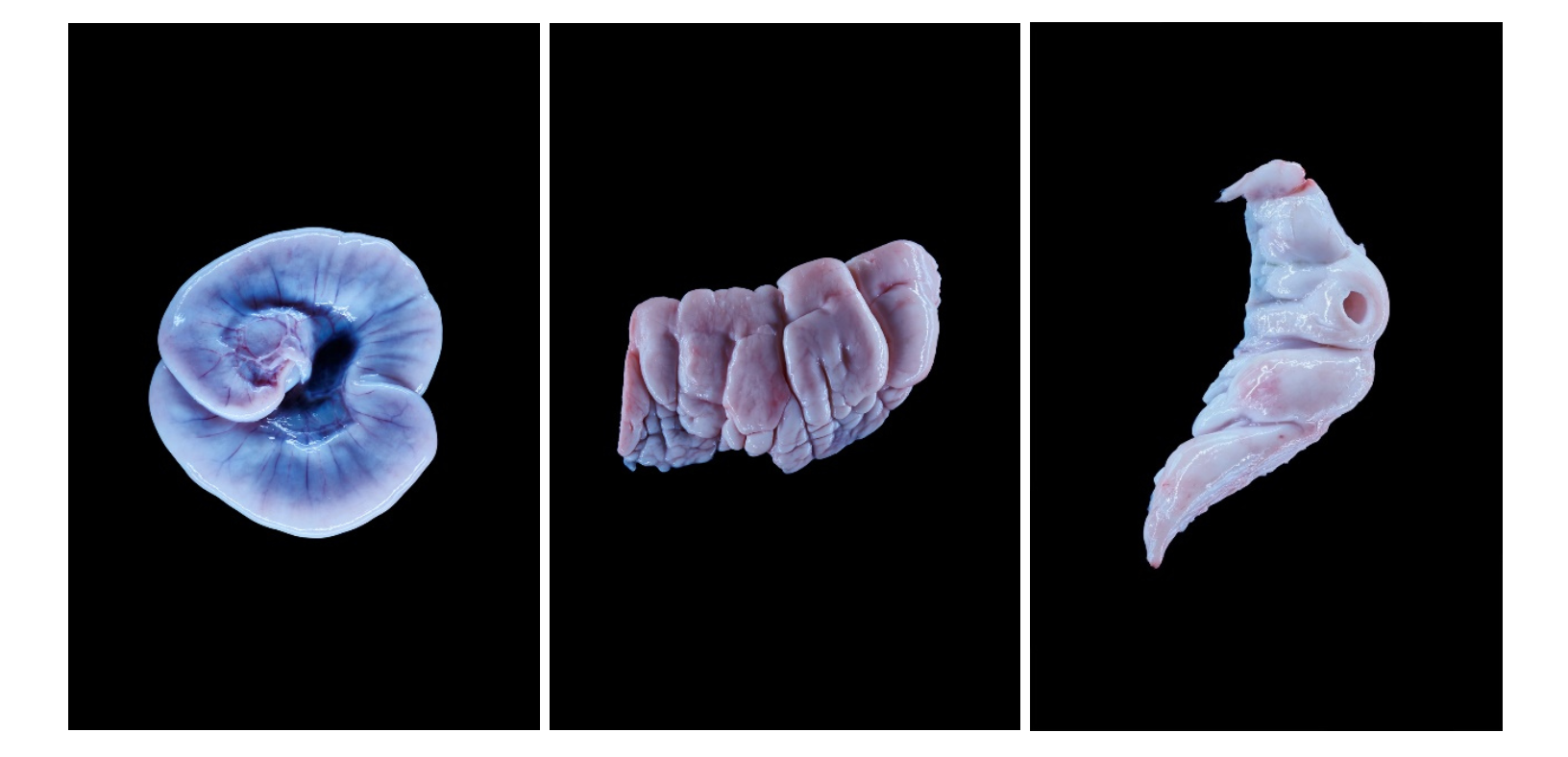Butcher meets art
The butchers are now getting involved in the art scene. This will be a shock! Heavy food in times of veggie mania. On closer inspection, it is a great surprise how the activity of a profession is reflected in the works of visual artists from antiquity to the present day. Almost at all times, artists have been inspired by motifs from the professional world of butchers. The history of art and the history of this very old craft are interwoven in many ways, since the butcher's craft is considered the oldest craft in the world and the appearance of art in the Stone Age marks the origin of culture.
In times of sometimes absurd nutritional debates, this exhibition is intended to remind people how closely meat is linked to human history and how far we have strayed from our origins. Maybe that's why only a few artists dare to approach this material.
Meat used in art today is an underestimated and taboo material.
Meat is ephemeral, raw, bloody, archaic.
The artist group Gotensieben has ventured into this material. In its best moments, art invites the viewer to confront it. Sometimes she pleases, sometimes she encounters rejection, nowadays she often lives on provocation. It's just that it's becoming increasingly rare for most artists to actually create a work that reaches people, doesn't leave them cold, that touches them, triggers approval, or even criticism and refusal.
And this is where the butcher meets art.
The butchers can live with the fact that a (small) part of the population rejects the profession. Being a butcher is rarely just a day job. You can only be a butcher if you are willing to put your heart and soul into this job. That connects the butcher with the artist.
The Metzgerei Seele & Söhne exhibition is all about resonance. The images appeal to the viewer, disturb him and initiate a thought process - or not. What do the images trigger in the viewer? What change of perspective do they allow?
One should not underestimate that in this case the butchers are the senders of the art action and thus enter the public discourse.

To be shown:
- historical recordings of the butcher's trade
- the group of works Souls by the artist group Gotensieben As children, Klaus Reichert and Thomas Balzer firmly believed that the soul was an organ hidden somewhere in the body. As members of the artist group, they went in search of their soul and found it. Since meat is the origin of all art themes, the members of the artist group Gotensieben came up with the idea of materializing souls through flesh. www.gotensieben.de

The artist group Gotensieben is thus continuing the long tradition of flesh in art.
History: On closer inspection, it is peculiar and very exciting how the activity of a profession is reflected in the works of visual artists from antiquity to the present day. Almost at all times, artists have been inspired by motifs from the professional world of butchers. The voluptuous fleshy curves of the Venus von Willendorf symbolize fertility. In the cave paintings, animal flesh is illustrated as food and totem, and thus as a symbol of power. In language, the soul has long been flesh. People believe in reincarnation and hope for transmigration. The incarnation of God takes place through incarnation (lat. incarnatio = incarnation).
Ever since Pieter Aertsen was the first to place a large piece of flesh at the center of one of his works in 1552 (Vanitas still life with Christ with Mary and Martha), painters have been captivated by flesh.
Pieces of meat also dominate the paintings of Rembrandt, Joachim Beuckelaer and Maerten van Cleve. Back then, only the rich could afford meat prepared by butchers, market women and kitchen maids.
For Vincenzo Campi, Bartolomeo Passerotti and Annibale Caracci, the common people who had to prepare the meat were considered vulgar, raw and devoted to the meat. The voluptas carnis, the lust of the flesh, became a synonym for a sinful life. Goya, Delacroix, Daumier and, again and again, Chaim Soutine devoted their paintings to the flesh (and not only there). Their lust for the flesh became corruption and death.
With Francis Bacon, the carnal nature of the figures and thus their decay is often the main theme: "As a painter, one must always remember that there is great beauty in the color of flesh."
Lucian Freud was also very aware of the power of the flesh: "The color is the flesh of painting". Flesh stands for earthly, corporeal, human and thus transient. In Viennese Actionism, artists around Hermann Nitsch wanted to break taboos and provoke a satiated society. Accusations of blasphemy were repeatedly raised against Nitsch. Animal rights activists also repeatedly protested against the handling of slaughtered animals as part of his bloody happenings.
The Meat exhibition has been taking place in the Altes Museum Berlin since June 1st. The announcement states:
Flesh: The barely moving basis of life, suddenly decomposing substance - repellent to some, food or offering to the gods to others. Meat reveals the pervasive conflict between life and death in human culture. The position of the flesh in the field of tension between creation and decay is paradoxical. The exhibition asks how this paradox influences the areas of nutrition, cult and body and thus also shapes our relationship to meat today.
A good question, we think. We answer them with our own exhibition.
presence
The art campaign Metzgerei Seele & Söhne condenses the relationship between butcher's trade and art in the 21st century through a series of exciting references:
- the artists' material comes from our slaughterhouses
- the artists make something visible that connects us all: the soul!
- as craftsmen with a centuries-old tradition, we are part of the soul of our society
- What we do (slaughter and produce food) is a very old cultural technique
- Killing, gutting, roasting was at the beginning of our culture
Only when people's basic needs for shelter and food were secured was it possible for culture to emerge at all.
Homo sapiens made small works of art out of bones, he painted cave walls with animals, animals that he had eaten.
After the roof over the head, the full stomach and the artfully painted walls, man came up with the spirits of nature and ultimately invented religion.
In the end everything is permeated by flesh and so the idea of making the soul visible through flesh, as the artists of the Gotensieben group of artists have done, is obvious. Her art reveals what cannot or should not or should not be shown.
Butcher shop Seele & Söhne in the Kunsthalle Ludwig
The Kunsthalle Ludwig in the west of the art metropolis Frankfurt is no longer an insider tip in the art community. Next to the city's museums, the Kunsthalle is probably one of the most beautiful places to show art.
Contact: Klaus Reichert
Tel. 0171 895 6823 / Email: This e-mail address is being protected from spambots To display JavaScript must be turned on!
Kunsthalle Ludwig / artist group Gotensieben / Office
Gotenstraße 5-7 / 65929 Frankfurt-Höchst
A joint production of the Kunsthalle Ludwig, the artist group Gotensieben and the butchers' guild Frankfurt-Darmstadt-Offenbach
19.09.2018 – 11.11.2018
15.00 p.m. – 18.00 p.m. and by appointment
